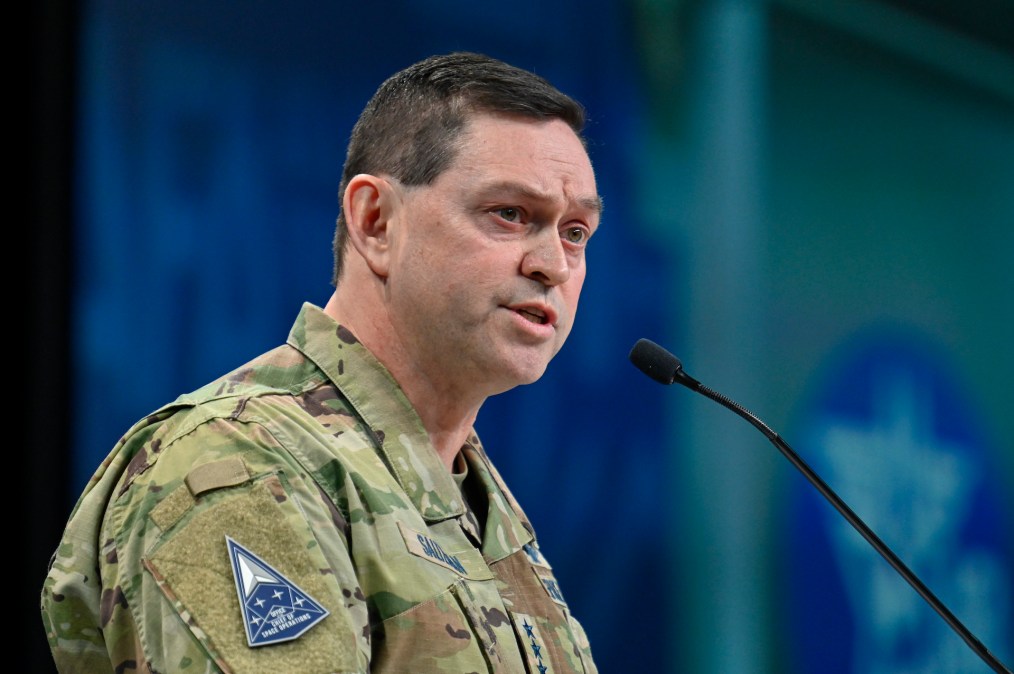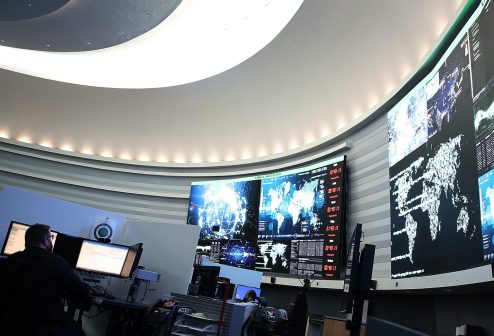From Z-grams to C-notes: Inside Gen. Saltzman’s unique approach to leading America’s digitally focused Space Force

AURORA, Colo. — As he executes on his at times “daunting” responsibilities to steer the United States’ newest high-tech military branch, Space Force leader Gen. Chance Saltzman is applying lessons and tactics from innovative leaders who served decades before this modern, digital age.
He personally writes and regularly sends Chief of Space Operations notices to guardians at all levels, for example, to share his evolving thoughts on priorities and invite discussion and debate on topics he views as critically important to the young force.
Deemed C-notes for short, Saltzman told DefenseScoop that he “admits freely that I stole” this idea from former Chief of Naval Operations Adm. Elmo “Bud” Zumwalt — who would disseminate his own Navy-wide “Z-grams” in the early 1970s to engage with the entire service on technology, policy and social reforms he was leading.
“Back in the ‘70s, I think they used, like, literally teletype, all-caps, [with distribution that was] very analog, if you will. I imagine some ships getting semaphore relays, I don’t know. It was a far different time in terms of what mass communication looked like in the early ‘70s. But this idea — that the chief of the service was trying to pass his words and his thoughts directly to the fleet — was just inspiring to me,” Saltzman said on Wednesday during an exclusive interview with DefenseScoop on the sidelines of the annual AFA Warfare Symposium.
Stimulating discussions
First commissioned by the Air Force in 1991, Saltzman is a career missile and space operations officer with degrees in history, strategic management and public administration. He’s been known broadly for the passion he’s always had for teaching and learning from his colleagues — even before he became the second-ever Space Force chief in 2022.
During a promotion ceremony in 2020, the first chief of space operations and Saltzman’s predecessor, Gen. John Raymond, shared an anecdote about a trip he’d gone on where Saltzman demonstrated that “defining quality.”
“Two young captains briefed me on what they were doing, and then I continued the tour. And for about another 20 or 30 minutes I was looking, and I said, ‘Where’d Gen. Saltzman go?’ Well, he was sitting down with those two captains teaching, and sitting down having a conversation, helping them think through what they had just briefed — and helping them understand the importance of the work they were doing,” Raymond recalled.
“[If] you think about Salty, that’s what I think of: as an instructor,” he added, referring to the senior official by his nickname.
In some ways, Saltzman’s C-notes are media through which he also exhibits that intent.
The general already knew a bit about the late Adm. Zumwalt when he was tapped to lead the brand new Space Force in 2022. But to prepare for the weighty role, Saltzman said he spent a lot of time researching who was considered the best military leader of all time, across the branches — and Zumwalt and his Z-grams “kept popping up.”
Zumwalt was a decorated war veteran and the youngest person to ever serve as CNO. When he assumed that role in 1970, Zumwalt immediately started pursuing a variety of moves to mitigate cultural problems like racism and sexism in the Navy, which was rampant at the time, and help modernize operations.
The dozens of Z-grams he shared as CNO were a vessel through which he directed those reforms and attempted to help motivate service members and new recruits after the U.S. withdrawal from Vietnam. Topics like emerging cryptographic procedures, ways for junior personnel to make suggestions to the CNO, ethics to institute around customer experience — among many others — were covered in the directives.
Nearly 50 decades after Zumwalt’s documents were widely disseminated, their legacy is now carrying on through Saltzman’s C-notes.
“We say we want to be a flat, highly agile force — so, what is it that we’re doing that inspires that? And this was one thing I thought I could do is try to communicate directly with the force. It’s my voice, my thoughts, straight to them in a way that they would say, ‘Okay, well, this is what at least the CSO is thinking about. This is what the CSO thinks is important, and he wants us to be thinking about and talking about these things, too,” Saltzman told DefenseScoop.
“And I think that creates this power of innovation and creative thought from the groundswell of people that will read it and have better ideas,” he added.
In all of his C-notes, Saltzman intends to highlight “the things that are important to the service,” which will inevitably change as time passes.
So far though, “I would say the first seven or eight have been capturing the reflections that I’ve had both in the run up to the job and in the first 90 days or so, as I went around and tried to uncover what other people were thinking about where we were as a service,” he noted.
Running down a list of some of that content so far, he said: “What are my high priorities? What are the lines of effort? Where do we need to focus our manpower and our limited resources? Because trying to do everything is a recipe for failure.”
So far, Saltzman hasn’t used generative artificial intelligence tools like ChatGPT to inform his drafts — “I ask it things like, ‘who’s the best basketball player ever?’ just to see what the criteria is that it comes up with. So, I just think it’s fun,” he said.
Still, that doesn’t mean he isn’t interested in applying digital capabilities to strengthen and gauge the impact of this sort of engagement. Saltzman confirmed that in terms of what’s next, he’d like to have his team capture and collect data about the C-notes’ influence and reach across the sprawling force. “Those kinds of statistics might be interesting,” he said.
In the near term though, responses Saltzman is receiving from guardians seem to be suggesting C-notes are achieving his ultimate aims of stimulating important new debates and discussion about the service and its operational future. During a recent series of engagements Saltzman attended with students, cadets and faculty at the Air Force Academy, for example, guardians asked him questions about specific inclusions in his C-notes.
“‘Tell me what you meant by this, or how does that apply to that?’” he explained.
“So, the feedback has been positive. And I’ll tell you, the best thing for me — it’s not like I hang out with brand new guardians every day — so when I do get the opportunity, it’s just a treat. And when I can hear them talking, and they don’t know that I’m standing there, like literally at a water fountain in a hallway, and I hear two guardians talking about a C-note — that’s just, like, perfect. Success. They’re having a discussion on important topics that I think are important to the service, and that was the real goal,” Saltzman said.
‘They expect it’
When the Space Force was first coming into fruition in early 2020, officials involved and early members “were starving for information,” Saltzman noted, about the policies, promotions, uniforms, and many other elements initiated by the branch’s establishment.
“There was just this thirst for ‘tell me what’s going on up there in the headquarters’ — so, I heard that loud and clear as I went around. And as a result, when I’m now in the field, they say: ‘Hey, love the C-note — keep them coming.’ They feel like they’re getting that direct connection, and they are getting that direct connection,” Saltzman said.
C-notes are part of his overarching leadership approach to guide the first U.S. military branch to primarily function using technological capabilities associated with emerging conflict domains — space and cyberspace — which Saltzman noted fundamentally centers on “two basic ideas.”
“One is, because we’re much smaller than the other services, the idea that we can throw manpower at something, or use processes that were designed for services of 300[,000] to 400,000 people in the same way with a much smaller service just doesn’t compute, right, to use a digital term,” Saltzman explained. “And then second, the people that are excited about coming to the Space Force, they expect it. They expect something different. They expect a different experience. If we sell them on high-tech space, and then they come in and they’re seeing archaic personnel processes, there’s this disconnect that just is disingenuous to our vision.”
Other members of the Space Force leadership team are also all-in on this approach. During a media roundtable at the symposium, the Space Force’s first and current Chief Master Sgt. Roger Towberman told DefenseScoop that the service has major opportunities to innovate “because of our size and because of the digital natives that we’re recruiting.”
While he doesn’t write any C-notes of his own, Towberman has a strong social media presence and heaps of online followers — and he also hosts his own podcast that Saltzman said is another virtual outlet for “some really great conversations.”
“The chief is a pro. He really does use, I think, the digital domain better than most senior leaders, quite frankly. I think he’s done a nice job,” Saltzman said.
While he considers himself more of an “observer” who is not highly active on social media by many people’s standards, Saltzman recognizes that there’s more communication and information available about what’s going on militarily than any generation that served before — and it’s mostly online. This week at the AFA conference he even learned of new grassroots groups and forums that are springing up on their own in the Space Force as “chapters” of guardians that are sharing their own insights and engaging in debates online.
“I mean, we just have to empower them, because they’re going to come up with so many great ideas,” Saltzman said.
And his C-notes mark one tool in which he feels he can lean into “enabling empowerment” for those and other savvy guardians operating anywhere on the planet.
“The goal is, if you’re going to be talking about things, please talk about the things that are important. So, I’m just trying to throw some ideas out there that these are important things. And I know they’re important because I’ve got 32 years of [military experience to draw from while] trying to figure out how we’re going to get better at this as a service. And so, hey — in your chat rooms, in your forums, in your training sessions, in your social gatherings, hey — talk about these things. Because these are the guys and gals that are going to grow up to be the colonels and the one-stars that are going to have to really drive this, and I want them to have that foundation of debate and foundation of discussion on these important topics,” Saltzman said.
According to him, empowering the force through this messaging — as well as other nascent engagements, resources and technologies — could lead to a more fulfilled, creative and inspired force that is therefore easier to retain.
“So, then they start to accumulate experience and be more innovative. When the guardians get really good — and the systems they design and the tactics they design are optimized for the domain we’re facing — our adversary is going to notice. And the better we are, the less likely they are to do things that are aggressive or hostile, and that has a deterrent effect. So, leadership and culture and innovation and creativity to get the most out of our guardians has a direct tie to deterrence against an adversary that says, ‘Is that who we want to go up against? Are we ready to tackle that group of people?’ And I think, on balance over the next few years, they’re going to go, ‘No, we don’t want to.’ This is an amazing group of people doing amazing things,” Saltzman said.






